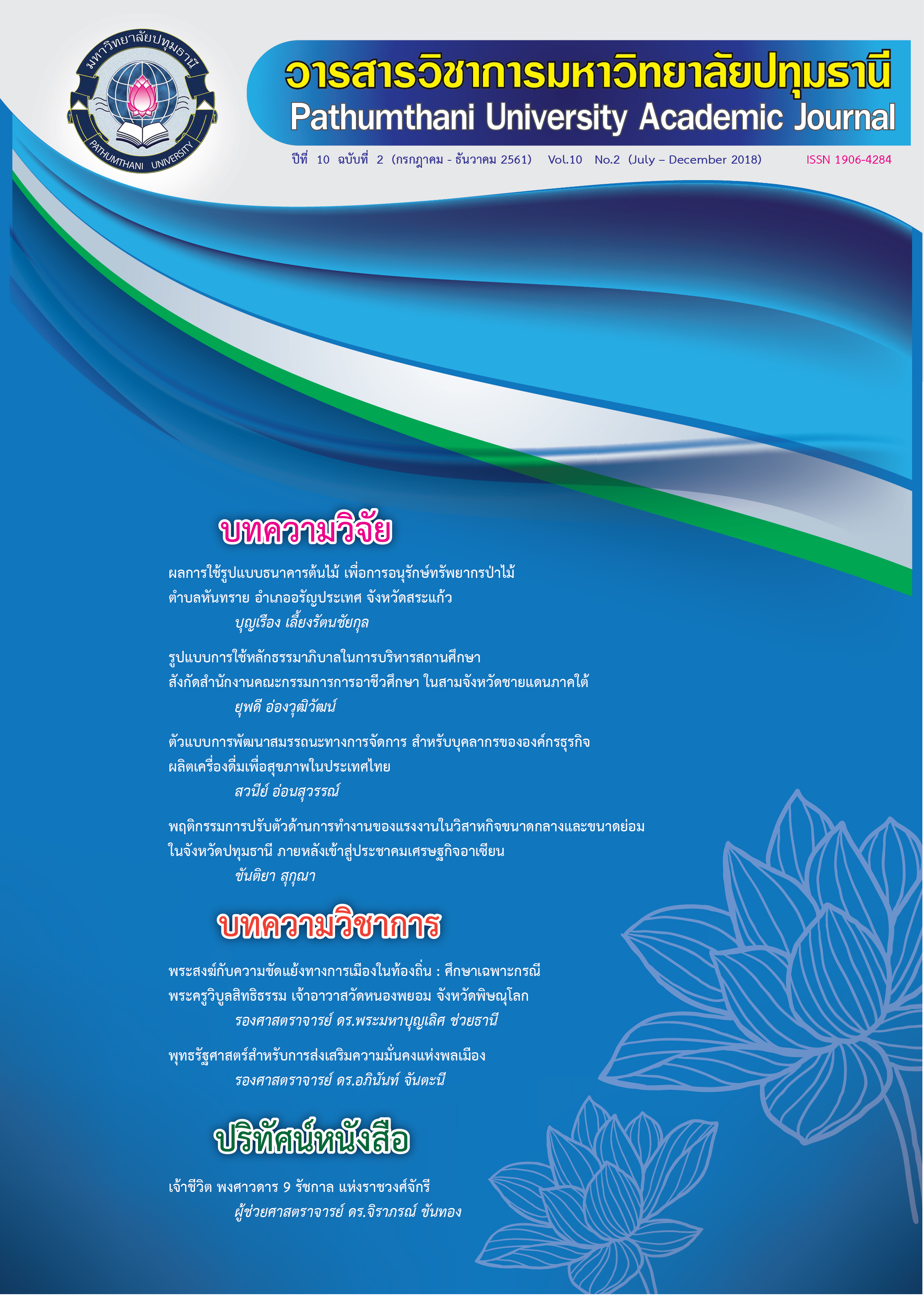การประเมินหลักสูตรพยาบาลศาสตรบัณฑิต (หลักสูตรปรับปรุง พ.ศ. 2555)
Keywords:
การประเมินหลักสูตรAbstract
This study is a descriptive research with an objective to evaluate the quality of nursing science curriculum (revision as of 2012). The Faculty of Nurse, Pathumthani University, studies problems and obstacles in curriculum management. The study’s sample consists of curriculum executive committees, instructors, current students, coaching nurses at training resources, graduates, and supervisors of the graduates. The study’s tool is a structured interview, the questionnaires and the study create a discussion group (Focus Group). The questionnaires are verified the validity of the tool by the experts. This study analyzes quantitative data by frequency, percentage, mean, and standard deviation. The study finds that 1. Curriculum management. Overall, the curriculum management is appropriate in all area. Nonetheless, the University should consider improving curriculum planning for some courses, instructor assignment according to their educational qualifications, and student preparation before their practical training. 2. Context. The curriculum context is consistent with the philosophy and vision of the University and of the Faculty of Nurse. The objectives and the structure of the curriculum are appropriate to the environment and target the learner and society. However, they are not applicable to the ASEAN community. 3. Input. The quality and qualifications of the instructors meet the Nursing Council criteria. However, the University should consider to improve the teaching-learning support, including the development of information technology. 4. Process. The teaching management is reasonable. 5. Output. In the learning achievement, the graduates are moderate qualitied. Nonetheless, in their practical training, the graduates should further improve their practical skills.
References
2. ขนิษฐา นันทบุตร. (2552). แผนที่การวิจัยกับวิชาชีพการพยาบาล. กรุงเทพมหานคร : ทีคิวพี.
3. ภัทรพร อรัณยภาค และคนอื่น ๆ. (2551). “การประเมินผลหลักสูตรพยาบาลศาสตรบัณฑิต คณะพยาบาลศาสตร์ มหาวิทยาลัยสยาม (ฉบับปรับปรุง พ.ศ. 2544) โดยใช้แบบจำลองซิปป์ (CIPP Model). ”วารสารการพยาบาลและการศึกษา. 3, 7-15.
4. ไพฑูรย์ สินลารัตน์. (2553). กลยุทธ์การสอนตามกรอบมาตรฐานคุณวุฒิระดับอุดมศึกษา. กรุงเทพมหานคร : โรงพิมพ์แห่งจุฬาลงกรณ์มหาวิทยาลัย.
5. ราชกิจจานุเบกษา. (2542). พระราชบัญญัติการศึกษาแห่งชาติ พ.ศ. 2542. เล่ม 116/ตอนที่ 74 ก/หน้า 1/19 สิงหาคม 2542.
6. ราชกิจจานุเบกษา. (2553). ประกาศกระทรวงศึกษาธิการ เรื่อง เกณฑ์มาตรฐานหลักสูตรระดับปริญญาตรี สาขาพยาบาลศาสตร์ พ.ศ.2552. เล่ม 127 ตอนพิเศษ 3 ง วันที่ 11 มกราคม 2553.
7. วิจารณ์ พานิช. (2554). วิถีสร้างการเรียนรู้เพื่อศิษย์ในศตวรรษที่ 21. กรุงเทพมหานคร : โรงพิมพ์บริษัทตถาตา พับลิเคชั่น จ ากัด.
8. วิชัย วงษ์ใหญ่. (2554). การพัฒนาหลักสูตรระดับอุดมศึกษา. พิมพ์ครั้งที่ 2. กรุงเทพมหานคร : อาร์ แอนด์ ปริ้นท์.
9. ศศิกาญจน์ สกุลปัญญวัฒน์. (2554). การประเมินหลักสูตรพยาบาลศาสตรบัณฑิต (หลักสูตรปรับปรุง พ.ศ. 2554). คณะพยาบาลศาสตร์ มหาวิทยาลัยอีสเทิร์นเอเชีย.
Downloads
Published
How to Cite
Issue
Section
License
บทความที่ได้รับการตีพิมพ์เป็นลิขสิทธิ์ของวารสารมหาวิทยาลัยปทุมธานี
ข้อความที่ปรากฎในบทความแต่ละเรื่อง เป็นความคิดเห็นส่วนตัวของผู้เขียน กองบรรณาธิการไม่จำเป็นต้องเห็นด้วยเสมอไป และไม่มีส่วนรับผิดชอบใด ๆ ถือเป็นความรับผิดชอบของผู้เขียนแต่เพียงผู้เดียว



